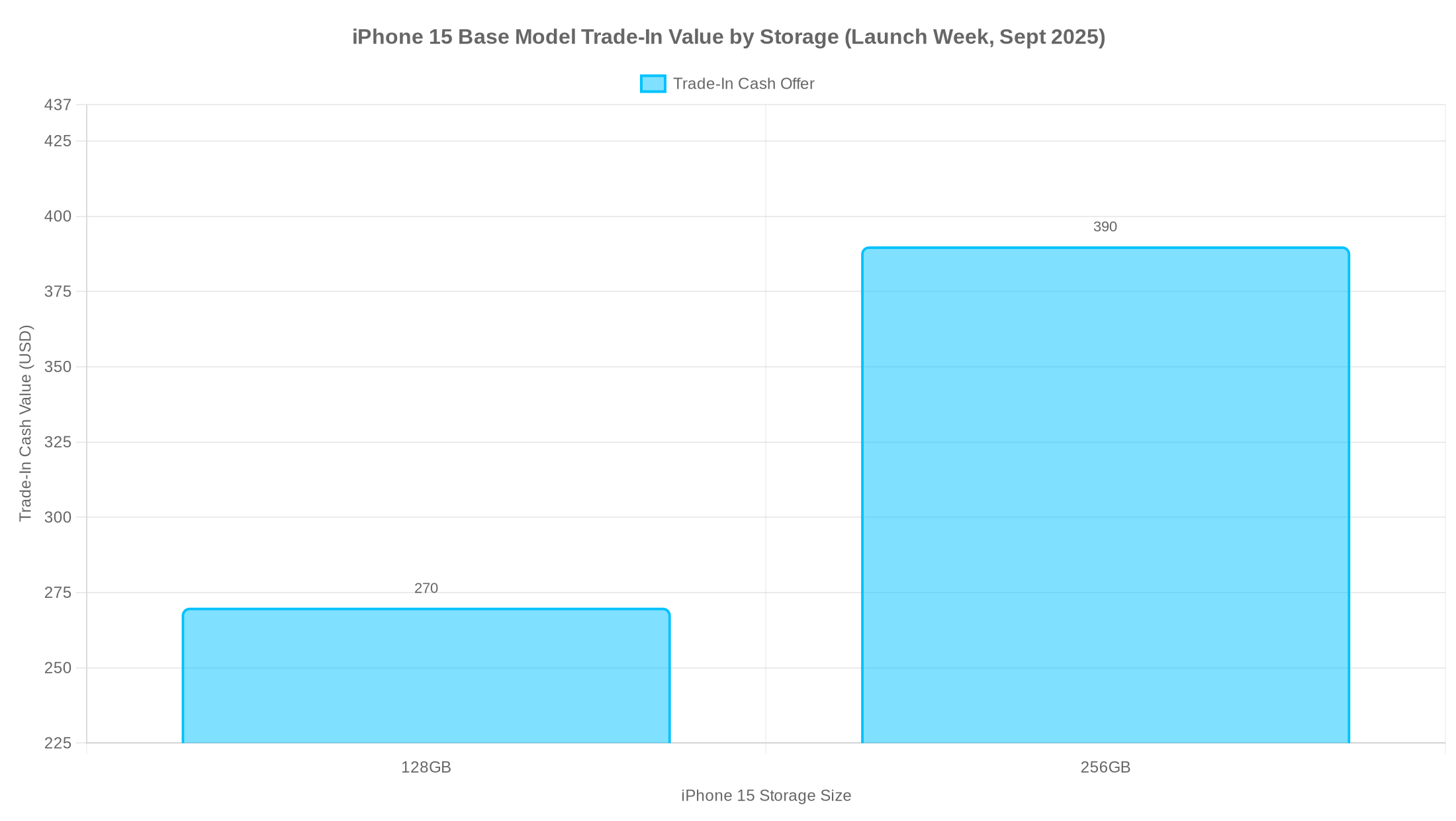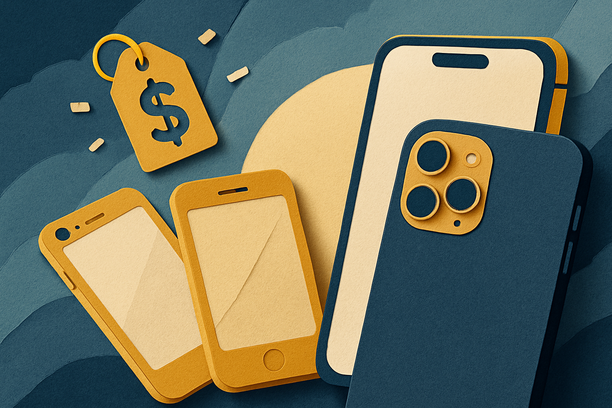Table of Contents
Key Takeaways
- The iPhone 17’s leap in power, camera, and baseline storage is already pushing down used iPhone prices—waiting could cost you hundreds.
- Base models and 128GB variants are most exposed; 256GB+ devices hold value longer thanks to shifting buyer expectations.
- Sell within the first month after launch to ride promo bumps and avoid the January slide; compare platforms before accepting any offer.
- Holiday promos look tempting, but many require upgrading—plan ahead to avoid missing your best window.
- Pro models decelerate more slowly, yet depreciation is inevitable—monitor weekly and act before Q4 ends.
The iPhone 17 Game-Changer: Why This Launch Hits Different
September 19, 2025, changed everything. Apple’s reveal didn’t just launch a new phone—it reset expectations for buyers and sellers. If you’re holding an iPhone 13, 14, 15, or 16, the value clock is already ticking for anyone aiming to sell an older iPhone.
The hardware leap is real. With an A19-class chip and a 48MP Main + Ultra Wide + Telephoto array, iPhone 17 makes recent devices feel last-gen overnight. The baseline now starts at 256GB—a subtle spec that massively shifts buyer expectations, especially versus 128GB models documented in this used iPhone buyer guide.
Design sends a message. The ultra-thin 17 Air replaces Plus, while Pro models add an all‑aluminum unibody—visual cues that older devices are yesterday’s tech. See the full details in Apple’s reveal of iPhone 17 Pro and Pro Max.
Durability got a big upgrade too: Ceramic Shield 2 boasts stronger scratch resistance, tilting buyers toward new—why risk scuffs when the latest laughs at damage?
“Specs didn’t just improve—they reset the standard buyers will use to judge every used iPhone from here on.”
Your Phone’s Value Is Dropping Right Now: The September Effect
Supply surged the moment preorders opened. As lines form for new models, trade-in activity spikes—more sellers, same buyers, lower prices. Track the cadence via launch and preorder timelines and what trade-in programs tend to offer in volatile windows in this trade‑in explainer.
History is consistent—drops get sharp fast. Following iPhone 15/16 launches, year‑old devices fell ~10–18% in weeks. Base models got hit hardest, though Pros still slid. See precedent around release cycles via major launch cycles and why iPhones generally hold value better—until a major spec reset like this.
This year’s psychology stings more. When shoppers see the 48MP system, vapor chamber cooling, and better battery in the new Pro line, “perfectly fine” phones feel old fast—details straight from Apple’s Pro/Pro Max announcement.
6‑Month Resale Value Forecast: What Your Phone Will Be Worth
October 2025: The Initial Shock. iPhone 15 Pro Max that fetched $600–650 at launch week likely settles to ~$520–580 by month’s end. Base iPhone 15s slip from $350–400 toward ~$290–340. iPhone 14 falls harder—Pro Max moving from ~$450–500 to ~$380–430.
November–December 2025: Holiday Pressure. Expect aggressive promos during Black Friday/Cyber Monday. Paradoxically, that’s when depreciation accelerates as retailers clear inventory. By December, base iPhone 15 often sits ~$250–300; iPhone 14 struggles to stay above $200. If you’re not upgrading, use our note on responsible end‑of‑life options rather than holding too long for a rebound.
January–March 2026: The New Normal. Post‑holiday floors emerge. 15 Pro Max stabilizes around $450–500; base 15 around $220–270. iPhone 14 Pro hovers ~$180–220, standard models ~$120–160.
Storage capacity will determine survival. 256GB+ models outlast 128GB peers as buyer expectations reset—see why storage sways demand in this used iPhone buyer breakdown. The 17’s 256GB baseline compounds that effect, as noted in the same guide.
The iPhone 13 reality check. By March 2026, most 13s trend under $120—worthy backups, but weak returns. If selling isn’t feasible, follow this safe disposal guide.
The Critical Decision: Sell Now or Wait?
Short answer: sell sooner. For iPhone 13/14 and base 15—especially 128GB—waiting erodes value week by week. If you’re ready, this walkthrough on selling via Facebook Marketplace can help you move quickly, and the buyer landscape guide shows who pays best for which models.
Who can wait (a bit)? 15 Pro and 16 Pro/Pro Max in excellent condition decline more slowly—Pro features remain relevant longer. Still, promo windows and carrier terms matter; compare against offers outlined in this carrier trade‑in explainer.
“In the post‑17 era, time is money—every week you delay is a step down the price ladder.”
Strategic Selling: Maximizing Your Return in the Post‑iPhone 17 World
Shop the platform, not just the price. Convenience vs. payout varies—Apple trade‑in can be great if you’re upgrading, while peer‑to‑peer or specialty resellers can pay more for pristine devices. See how offers differ and what fine print to watch in this trade‑in pros/cons guide.
Time the market. Historically, promo boosts cluster just before and after launch, then fade. The sweet spot is the first month after release—early enough to avoid steep depreciation, late enough to catch bonuses. The who‑buys‑iPhones guide details buyer demand patterns you can use to time the exit.
Bundle smartly. Carriers sometimes add $200–400 in value when you activate a new line/plan. If upgrading anyway, these bundles can beat standalone sales—see scenarios in the buyer guide.
The Storage Factor: Why Capacity Determines Your Phone’s Future

128GB is the new “small.” With iPhone 17 starting at 256GB, half‑capacity devices feel cramped from day one—buyers know it. See how this perception plays out in the used buyer deep dive.
256GB+ holds the line. More headroom means fewer compromise decisions for buyers, slower depreciation for sellers, and faster transactions overall—patterns the buyer guide underscores.
Pricing psychology is unforgiving. Put a 128GB at $300 next to a 256GB at $350 and the larger capacity wins on “value.” The result: 128GB sellers discount to compete—reinforced by why iPhones generally retain value better when spec’d right.
Black Friday and Holiday Impact: Navigating the Season’s Chaos
Promo windows, not magic bullets. Expect short-lived bumps during Black Friday week. Many require a new device or line, so if you’re not upgrading, plan to sell before Thanksgiving or watch for micro‑windows right after launch promos hit.
January bites hard. Gifted upgrades flood the market with trade‑ins; promos end; prices reset lower. If you miss the late‑fall window, you’ll likely face softer offers through Q1.
What Makes This Year Different: The Pro Features Trickle‑Down Effect
Content creation got a boost. New video features like ProRes RAW and Apple Log 2 elevate the bar for creators—older phones can’t keep up with modern workflows, per Apple’s iPhone 17 announcement.
Battery and thermals matter daily. With A19 and vapor chamber cooling, longer battery life becomes normal. Phones needing an afternoon top‑off feel broken by comparison—see the Pro details in Apple’s Pro reveal.
Real‑World Pricing: Current Snapshot and Trends
iPhone 15 Pro Max: Apple trade‑ins ~$480–650 depending on condition/storage; third‑party markets ~ $520–680 when demand is hot.
iPhone 15 (base): Roughly ~$220–390, with 256GB commanding the top end while 128GB struggles to clear $300.
iPhone 14 series: Pro Max around ~$380–450; standard ~ $180–280 as the two‑generation gap shows.
iPhone 13 and older: Commonly under $200 now, with many trending to sub‑$100 by holidays—if you won’t sell, consider safe disposal and recycling.
Values update weekly as platforms recalibrate to supply, demand, and promo competition—the direction through Q4 is down.
Making the Call: Your Action Plan for Maximum Value
iPhone 13 and older — Sell now. Every week costs real money. If you want a quick, clean sale, try this walkthrough on selling via Facebook Marketplace.
iPhone 14 — Strong sell. The three‑generation gap is growing; buyers will increasingly bypass these for newer storage and camera standards. Get a feel for who pays best in the who‑buys‑iPhones guide.
iPhone 15 (base, especially 128GB) — Sell. The 256GB baseline on 17 makes your phone feel tight on space. See demand drivers in the buyer landscape.
iPhone 15 Pro and 16 Pro — Monitor, then move. You have more runway, but depreciation won’t stop. Track carrier boosts and trade‑in terms with this carrier trade‑in guide.
Bottom line: In a 256GB‑first world with bigger camera and battery leaps, yesterday’s flagship becomes tomorrow’s budget phone—fast.
Frequently Asked Questions
When is the best time to sell after a new iPhone launch?
Within the first month. That window balances early promo bumps with pre‑holiday demand and avoids the sharp January reset. If you wait, plan to watch weekly movements and act before prices cascade.
Should I trade in with my carrier or sell privately?
It depends on your priorities. If you’re upgrading and value convenience, carrier or Apple trade‑in can be solid; for top dollar on pristine devices, private sale/marketplaces often win. Compare terms using this trade‑in pros and cons guide.
Does storage capacity really change resale value?
Yes—dramatically this cycle. With iPhone 17 starting at 256GB, 128GB models feel constrained and price down accordingly; see buyer behavior nuances in the used iPhone buyer guide.
How do I prep my iPhone for sale safely?
Before listing: back up your data, sign out of Apple ID/Find My, erase all content and settings, and clean the device. Keep accessories/box if you have them—they can nudge your price up.
Is Black Friday the best time to sell?
Only if you’re upgrading and can use bundled trade‑in promos. Otherwise, sell before Thanksgiving or target early post‑launch promo weeks—see typical offer patterns in Black Friday trade‑in roundups.
